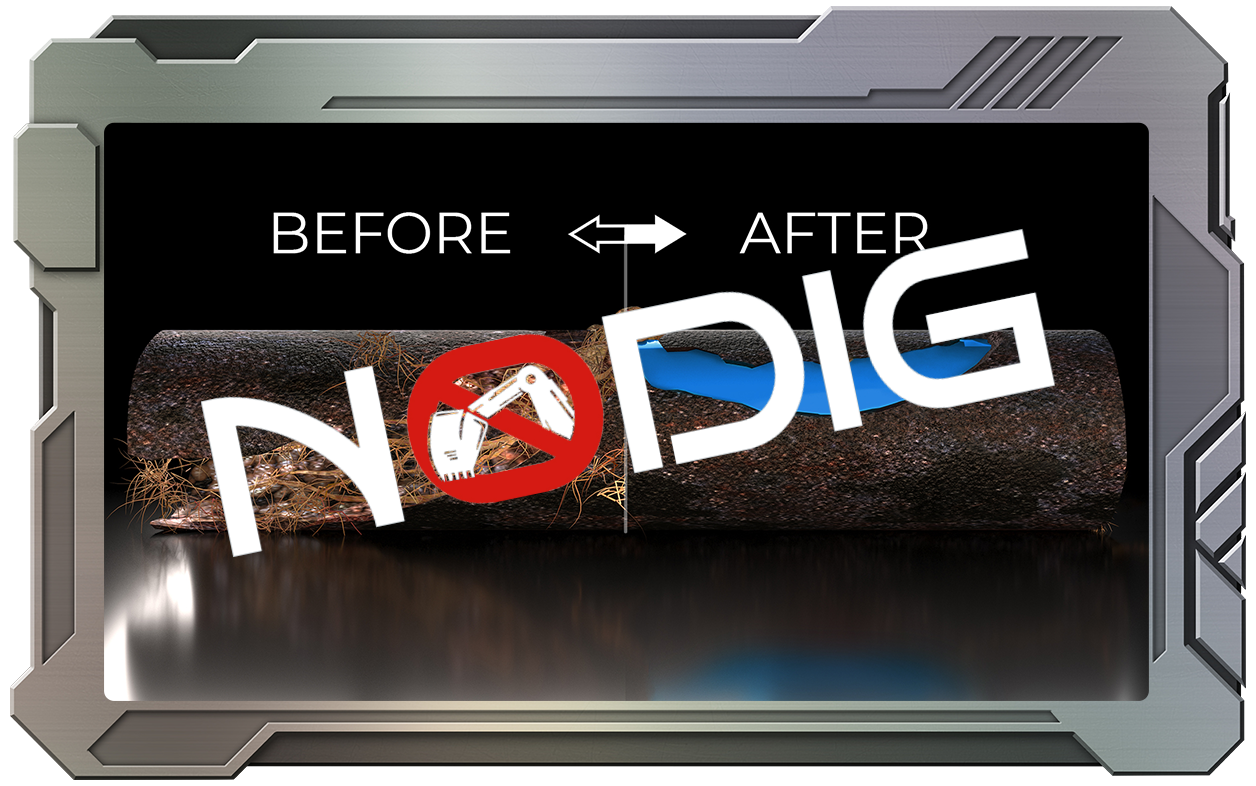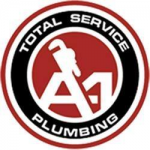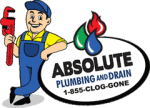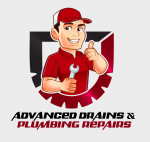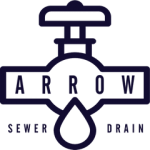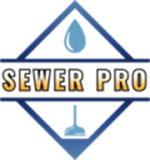Considering trenchless pipe lining as your chosen method of repair for your old pipe or drain? Not sure what it is and how to do it properly?
We've got a full guide to trenchless pipe lining, including its benefits, the different types of pipe lining, and a step-by-step process on how to go through the repair process.
What Is Trenchless Pipe Lining?
Trenchless pipe lining is a minimally invasive form of pipe rehabilitation. This trenchless method means you'll only have minimal digging.
This is the BEST SOLUTION for many homeowners that don't want time-consuming repairs compared to traditional pipe repair.
Traditional methods require digging, which can damage your yard and property, cause root intrusion, and have a long installation time.
How Does Trenchless Pipe Lining Work?
Trenchless pipe lining works by inserting a machine into the host pipe and using advanced technology to reinforce the structural integrity of the original pipe with a liner.
This is not as invasive compared to traditional repair methods, and there are different types you can consider, which will be discussed further below.
The Benefits of Trenchless Pipe Lining
Using trenchless methods for pipe rehabilitation or repair may cost thousands, but they have benefits that are more than worth it compared to the costs
#1 Affordability
Doing a sewer pipe repair through pipe lining is more COST EFFECTIVE than opting for a pipe replacement.
Traditional installation of a replacement pipe can cost from $50-$250 per foot.
This doesn't include the excavation costs, as it requires digging. Putting it back together, moving heavy objects, and re-landscaping your yard and property adds to the overall cost.
In comparison, trenchless pipe repair or lateral pipe lining costs from $80 and $250 per foot. There aren't many additional expenses compared to traditional methods.
#2 Speed
Another benefit to trenchless pipe lining is the installation speed. Without doing much digging, the repair process will be QUICKER.
Many contractors have a process in lining technologies that can detect the specific points where your sewer pipes need repairs, which speeds it up even more.
It's also faster than replacing a damaged pipe because you'd have to dig it up and remove any other debris that comes with that method.
#3 Cleanliness
Without digging, you don't need to remove debris, dirt, or other material and reinstall any grass or landscaping that was previously there.
Once the installation process for trenchless sewer line pipe repair is done, your property will look nearly as clean as it was before.
The Downsides of Trenchless Pipe Lining
It isn't all just benefits. There are some downsides to choosing to install a trenchless pipe liner in your sewer pipe:
#1 Dependent on the Condition of Your Sewer Lines
If your water pipes are poorly corroded BEYOND REPAIR, then the contractor may not want to do pipe lining on your sewer line.
Badly corroded pipes (like cast iron) where repairs might not work means you have to replace them. Your installation costs will increase if you choose to replace them.
#2 Not Available for All Property and Sewer Line Layouts
Some sewer lines run under the house and exit in hard-to-reach places, or even on your neighbor's property.
This means that UNLESS you had previous existing access points or know where a possible access point is, then there's a possibility you can't go through the trenchless installation process.
#3 Not Available in All Locations
Finally, some areas aren't serviced or reachable by contractors that provide repairs via trenchless pipe lining.
The advanced tech they use is expensive and needs to be transported around, meaning there's a chance they may not be able to provide services to you.
The Types of Trenchless Pipe Lining/Trenchless Pipe Repair
There are different types of pipe lining repairs that can be done depending on the state of your water pipes or sewer line and the contractor's suggestions. Here are a few of them:
Cured-in-Place Pipe Lining
CIPP uses a resin-impregnated tube that is inserted or pulled into place and cured in place with compressed air to form a pipe within a pipe.
This can also be used with vent systems, not just pipes.
Slip-Lining
Slip lining uses materials like HDPE, PE, FRP, and PVC (polyvinyl chloride) to create a slightly reduced diameter new pipe inside the old one.
The annular space is then filled with grouting.
Pipe Bursting
Using a bursting head, the original pipe is destroyed, and a new one is installed. The advantage of this method is that you can increase the diameter of your pipes if you wish.
Spiral Wound Lining
Spiral wound lining is a wound PVC pipe that's installed inside the sewer line. The advantage of this is that it can be installed WITHOUT interrupting water flow and is fully structural.
This is applicable to storm drains, culverts, street drains, and gravity sewer lines.
Spray-in-Place Pipe
SIPP involves coating the inside of water pipes with a reinforcing material. This doesn't affect water quality, as it's still potable water.
This method is best for pipes that carry safe drinking water.
How to Do Trenchless Pipe Lining in 8 Steps
Now, we'll move to the step-by-step guide to lining your pipes:
Step 1: Determine the Issue
A camera is usually inserted into the sewer line or water pipe to check where the issue is and if you need to replace or repair the pipe.
If you feel like there's a leak but don't know why, there are more high-tech methods to detect leaks.
Step 2: Clean Your Pipeline
Once the issue is found, the pipe needs to be CLEANED of all dirt or other objects that can interfere with the process.
Step 3: Measure Your Pipes
The next step is to measure the pipes to determine how much lining for the equivalent pipe materials you need.
Step 4: Mix Your Resin
After you know how much material you need, you should mix the resin.
Step 5: Pour Your Resin into the Liner
After mixing the resin, pour it into the liner. It will be rolled many times to ensure that the liner is FULLY IMPREGNATED by the resin.
Step 6: Load Your Liner into the Inverter
The inverter is the machine that will insert the liner into the pipes. Load it in.
Step 7: Insert the Liner into Your Existing Pipe
Look for the opening of the existing pipe and insert the liner there using the inverter.
Step 8: Invert Your Liner With Air Pressure
Once the liner is fully inserted, air pressure will be deployed to ensure the resin FULLY BONDS with the current pipe and properly reinforces it.
Traditional vs. Trenchless Pipe Lining Services
There are many benefits that trenchless pipe lining offers compared to traditional services. Here are a few:
- Not a lot of digging is needed, and the landscape is retained in its original form.
- It's faster as it requires less than a day of work
- The material used is very durable, as it lasts over half a century.
- No open pits for people or pets to fall into
- Limiting exposure to dangerous chemicals
- Old pipes don't need to be removed
- Traditional services may need separate contractors for the lining and landscape repair
- More labor costs for traditional services
Frequently Asked Questions
You might still have some questions about these processes. We've included the most commonly asked questions below:
High-density polyethylene (HDPE) is the most common material used for repairs because of its strength and durability. It won't need to be replaced anytime soon.
Relining lasts a minimum of 30 years to upwards of 50 years. It's around the same time you'd expect a replaced pipe to last, but is cheaper and more convenient to install.
It can cost from $80 to $250 per linear foot, but the sewer repair cost will depend on the contractor and supplier.
Pipe relining is a no-brainer choice if you want a MORE CONVENIENT option that won't disrupt your daily life and give you many headaches. It's definitely worth it!
Conclusion
Many homeowners will benefit from any non-invasive trenchless pipe lining method when trying to fix their drain, sewer lines, or water mains.
Other than taking up less time and being more convenient, this method is cheaper if you factor in other costs when considering traditional methods!
It's great to be listed on NoDig
-
Join a network of verified sewer repair specialists
-
Get recognized
-
Update your business information
Unlock your listing in minutes.
